Strategic Management Report: Analysing Google's Competitive Strategy
VerifiedAdded on 2023/06/08
|15
|5252
|478
Report
AI Summary
This report provides a comprehensive strategic analysis of Google, examining its development since its IPO, the strategies it employs, and their strengths and weaknesses. It includes a PESTEL analysis to evaluate Google's current turbulent global environment, assessing opportunities and threats. Furthermore, Porter's Five Forces analysis evaluates the attractiveness of Google's industry sector. The report also uses Porter's generic strategy framework to analyse Google's corporate and competitive strategies and assesses the growth strategies adopted by Google with the Ansoff Matrix, providing future recommendations for the company. Desklib offers a wide range of study resources, including solved assignments and past papers, to support students in their academic pursuits.
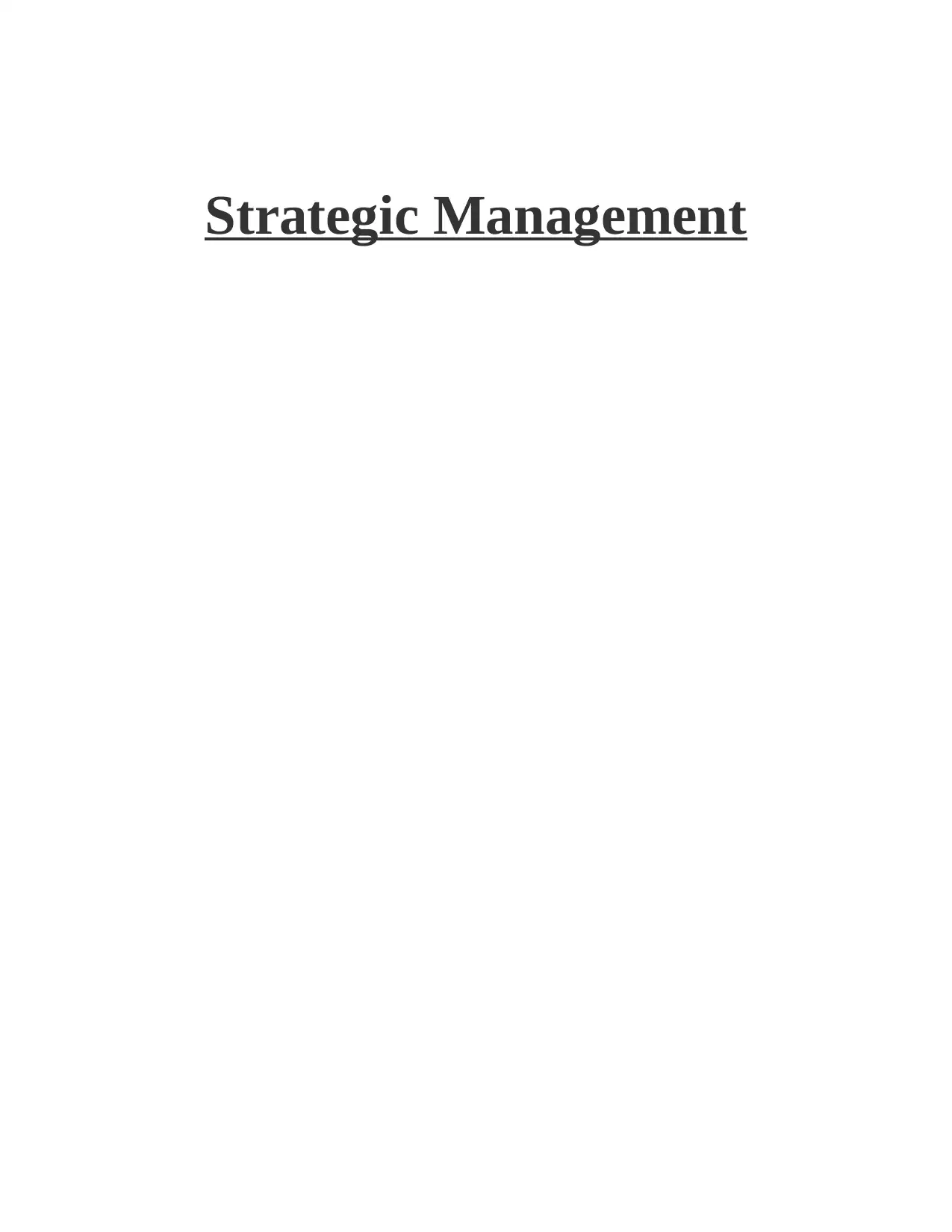
Strategic Management
Paraphrase This Document
Need a fresh take? Get an instant paraphrase of this document with our AI Paraphraser
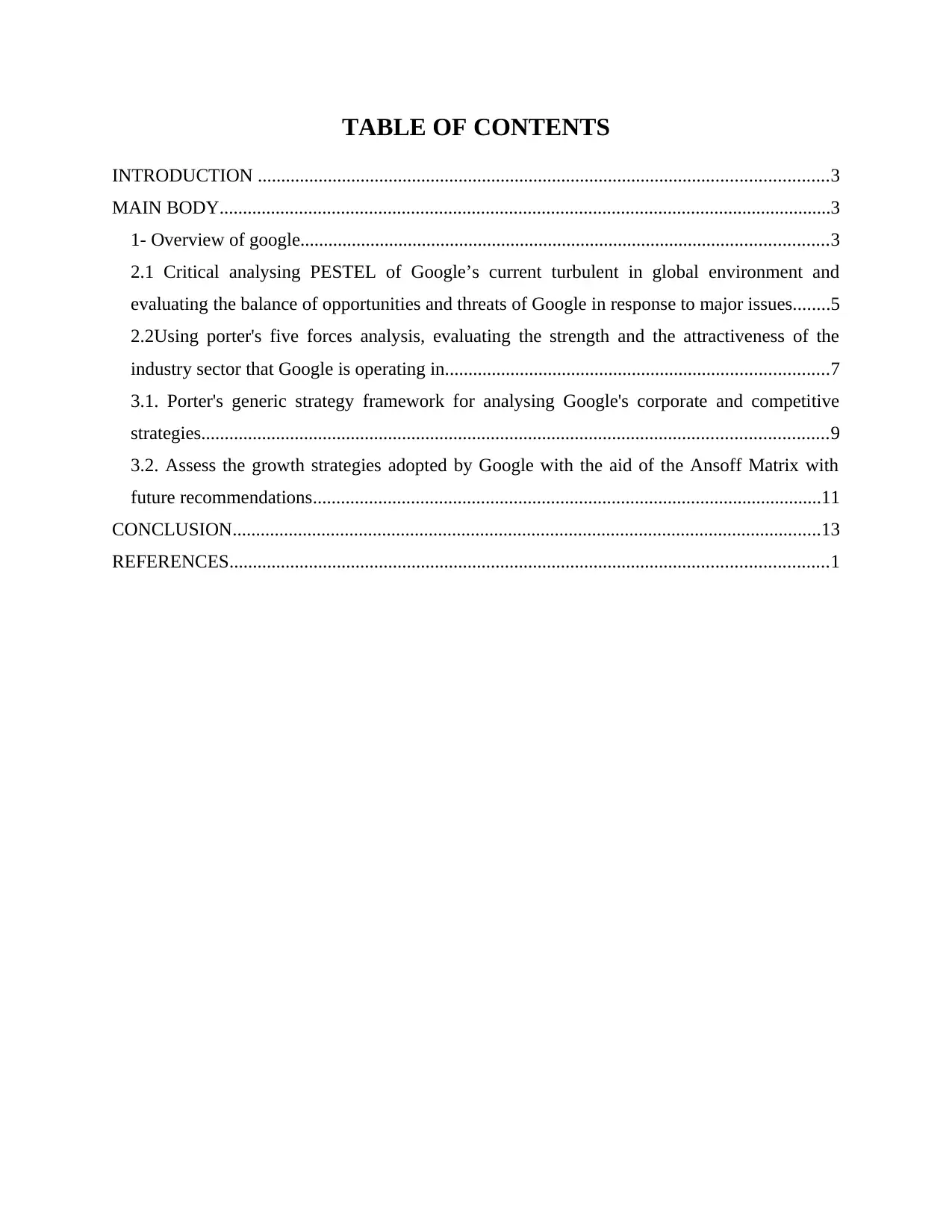
TABLE OF CONTENTS
INTRODUCTION ..........................................................................................................................3
MAIN BODY...................................................................................................................................3
1- Overview of google.................................................................................................................3
2.1 Critical analysing PESTEL of Google’s current turbulent in global environment and
evaluating the balance of opportunities and threats of Google in response to major issues........5
2.2Using porter's five forces analysis, evaluating the strength and the attractiveness of the
industry sector that Google is operating in..................................................................................7
3.1. Porter's generic strategy framework for analysing Google's corporate and competitive
strategies......................................................................................................................................9
3.2. Assess the growth strategies adopted by Google with the aid of the Ansoff Matrix with
future recommendations.............................................................................................................11
CONCLUSION..............................................................................................................................13
REFERENCES................................................................................................................................1
INTRODUCTION ..........................................................................................................................3
MAIN BODY...................................................................................................................................3
1- Overview of google.................................................................................................................3
2.1 Critical analysing PESTEL of Google’s current turbulent in global environment and
evaluating the balance of opportunities and threats of Google in response to major issues........5
2.2Using porter's five forces analysis, evaluating the strength and the attractiveness of the
industry sector that Google is operating in..................................................................................7
3.1. Porter's generic strategy framework for analysing Google's corporate and competitive
strategies......................................................................................................................................9
3.2. Assess the growth strategies adopted by Google with the aid of the Ansoff Matrix with
future recommendations.............................................................................................................11
CONCLUSION..............................................................................................................................13
REFERENCES................................................................................................................................1
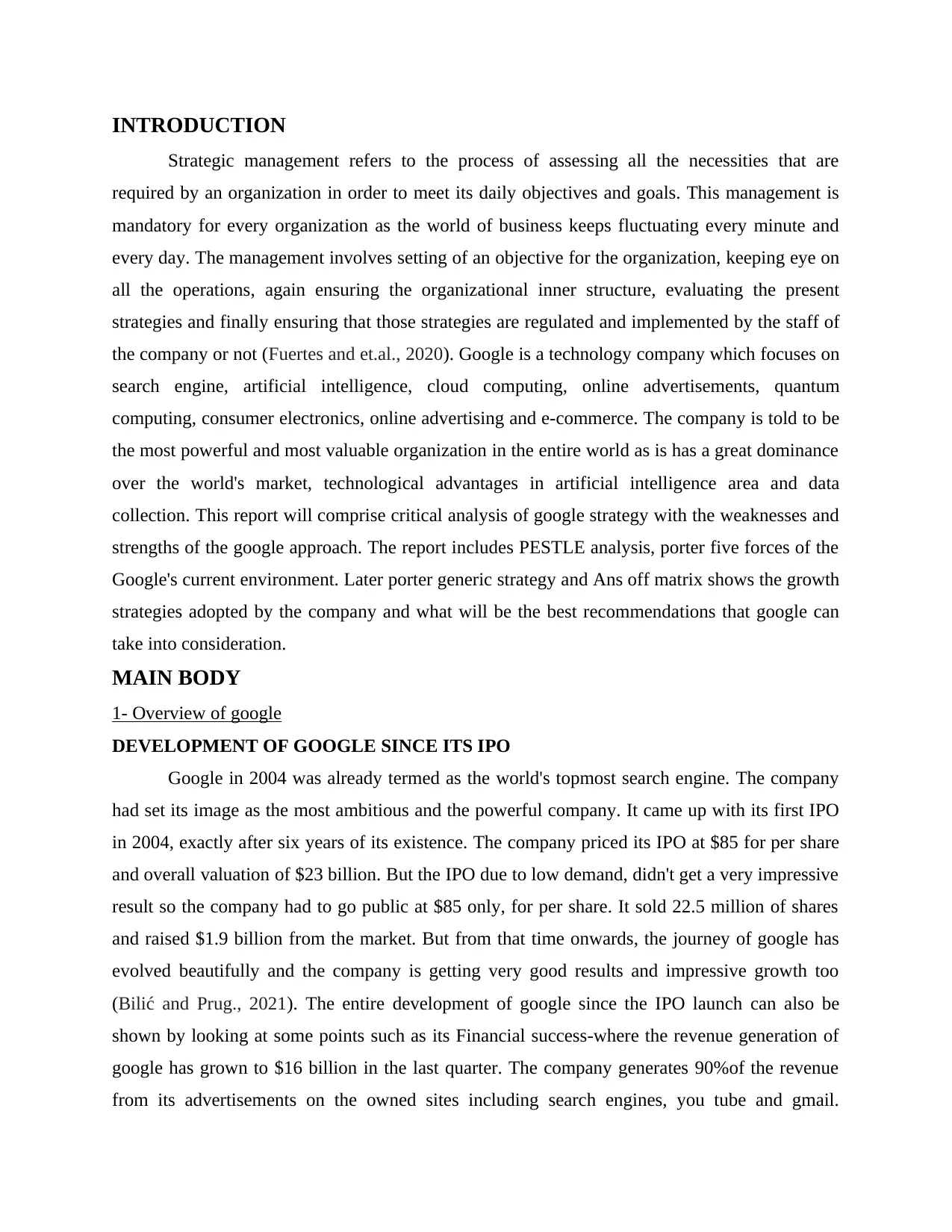
INTRODUCTION
Strategic management refers to the process of assessing all the necessities that are
required by an organization in order to meet its daily objectives and goals. This management is
mandatory for every organization as the world of business keeps fluctuating every minute and
every day. The management involves setting of an objective for the organization, keeping eye on
all the operations, again ensuring the organizational inner structure, evaluating the present
strategies and finally ensuring that those strategies are regulated and implemented by the staff of
the company or not (Fuertes and et.al., 2020). Google is a technology company which focuses on
search engine, artificial intelligence, cloud computing, online advertisements, quantum
computing, consumer electronics, online advertising and e-commerce. The company is told to be
the most powerful and most valuable organization in the entire world as is has a great dominance
over the world's market, technological advantages in artificial intelligence area and data
collection. This report will comprise critical analysis of google strategy with the weaknesses and
strengths of the google approach. The report includes PESTLE analysis, porter five forces of the
Google's current environment. Later porter generic strategy and Ans off matrix shows the growth
strategies adopted by the company and what will be the best recommendations that google can
take into consideration.
MAIN BODY
1- Overview of google
DEVELOPMENT OF GOOGLE SINCE ITS IPO
Google in 2004 was already termed as the world's topmost search engine. The company
had set its image as the most ambitious and the powerful company. It came up with its first IPO
in 2004, exactly after six years of its existence. The company priced its IPO at $85 for per share
and overall valuation of $23 billion. But the IPO due to low demand, didn't get a very impressive
result so the company had to go public at $85 only, for per share. It sold 22.5 million of shares
and raised $1.9 billion from the market. But from that time onwards, the journey of google has
evolved beautifully and the company is getting very good results and impressive growth too
(Bilić and Prug., 2021). The entire development of google since the IPO launch can also be
shown by looking at some points such as its Financial success-where the revenue generation of
google has grown to $16 billion in the last quarter. The company generates 90%of the revenue
from its advertisements on the owned sites including search engines, you tube and gmail.
Strategic management refers to the process of assessing all the necessities that are
required by an organization in order to meet its daily objectives and goals. This management is
mandatory for every organization as the world of business keeps fluctuating every minute and
every day. The management involves setting of an objective for the organization, keeping eye on
all the operations, again ensuring the organizational inner structure, evaluating the present
strategies and finally ensuring that those strategies are regulated and implemented by the staff of
the company or not (Fuertes and et.al., 2020). Google is a technology company which focuses on
search engine, artificial intelligence, cloud computing, online advertisements, quantum
computing, consumer electronics, online advertising and e-commerce. The company is told to be
the most powerful and most valuable organization in the entire world as is has a great dominance
over the world's market, technological advantages in artificial intelligence area and data
collection. This report will comprise critical analysis of google strategy with the weaknesses and
strengths of the google approach. The report includes PESTLE analysis, porter five forces of the
Google's current environment. Later porter generic strategy and Ans off matrix shows the growth
strategies adopted by the company and what will be the best recommendations that google can
take into consideration.
MAIN BODY
1- Overview of google
DEVELOPMENT OF GOOGLE SINCE ITS IPO
Google in 2004 was already termed as the world's topmost search engine. The company
had set its image as the most ambitious and the powerful company. It came up with its first IPO
in 2004, exactly after six years of its existence. The company priced its IPO at $85 for per share
and overall valuation of $23 billion. But the IPO due to low demand, didn't get a very impressive
result so the company had to go public at $85 only, for per share. It sold 22.5 million of shares
and raised $1.9 billion from the market. But from that time onwards, the journey of google has
evolved beautifully and the company is getting very good results and impressive growth too
(Bilić and Prug., 2021). The entire development of google since the IPO launch can also be
shown by looking at some points such as its Financial success-where the revenue generation of
google has grown to $16 billion in the last quarter. The company generates 90%of the revenue
from its advertisements on the owned sites including search engines, you tube and gmail.
⊘ This is a preview!⊘
Do you want full access?
Subscribe today to unlock all pages.

Trusted by 1+ million students worldwide
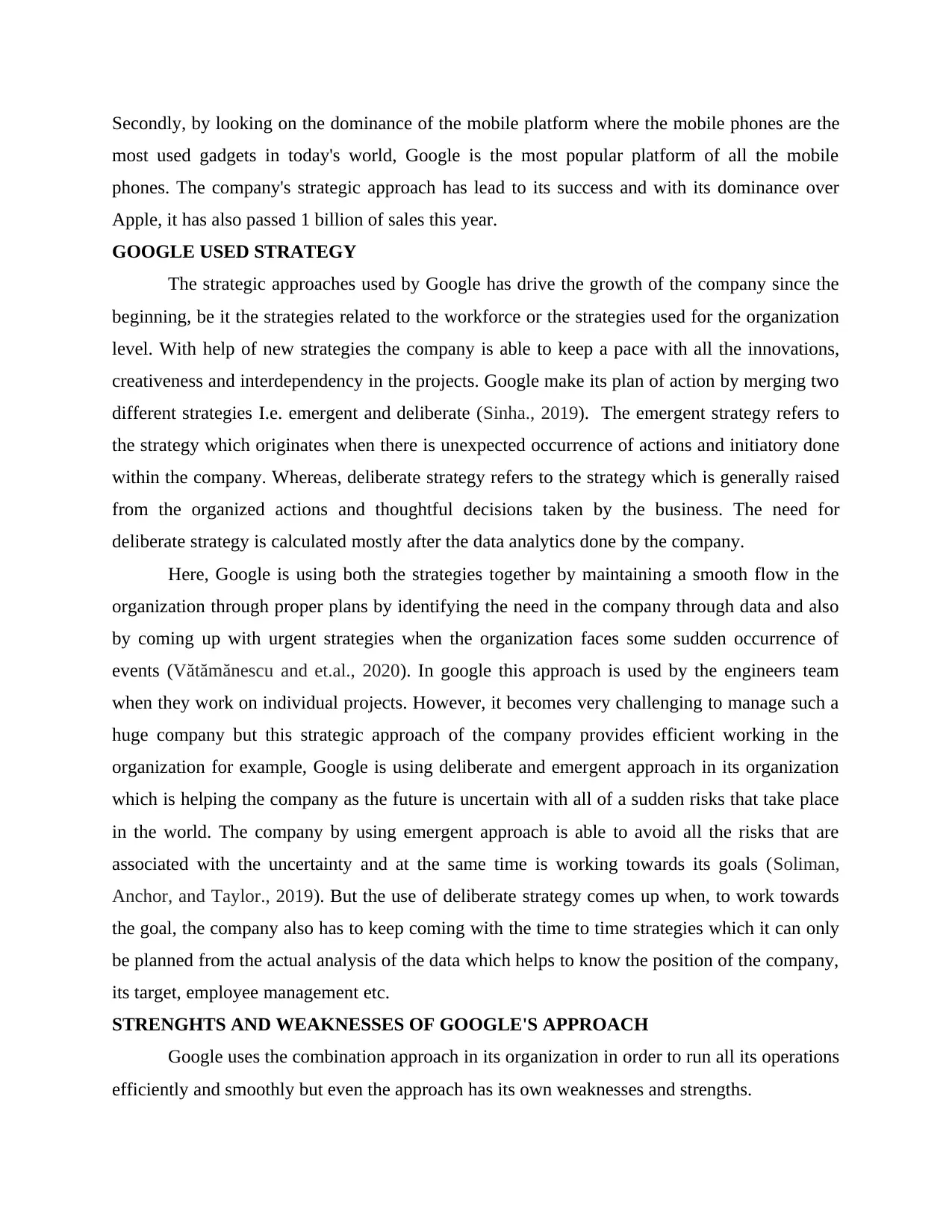
Secondly, by looking on the dominance of the mobile platform where the mobile phones are the
most used gadgets in today's world, Google is the most popular platform of all the mobile
phones. The company's strategic approach has lead to its success and with its dominance over
Apple, it has also passed 1 billion of sales this year.
GOOGLE USED STRATEGY
The strategic approaches used by Google has drive the growth of the company since the
beginning, be it the strategies related to the workforce or the strategies used for the organization
level. With help of new strategies the company is able to keep a pace with all the innovations,
creativeness and interdependency in the projects. Google make its plan of action by merging two
different strategies I.e. emergent and deliberate (Sinha., 2019). The emergent strategy refers to
the strategy which originates when there is unexpected occurrence of actions and initiatory done
within the company. Whereas, deliberate strategy refers to the strategy which is generally raised
from the organized actions and thoughtful decisions taken by the business. The need for
deliberate strategy is calculated mostly after the data analytics done by the company.
Here, Google is using both the strategies together by maintaining a smooth flow in the
organization through proper plans by identifying the need in the company through data and also
by coming up with urgent strategies when the organization faces some sudden occurrence of
events (Vătămănescu and et.al., 2020). In google this approach is used by the engineers team
when they work on individual projects. However, it becomes very challenging to manage such a
huge company but this strategic approach of the company provides efficient working in the
organization for example, Google is using deliberate and emergent approach in its organization
which is helping the company as the future is uncertain with all of a sudden risks that take place
in the world. The company by using emergent approach is able to avoid all the risks that are
associated with the uncertainty and at the same time is working towards its goals (Soliman,
Anchor, and Taylor., 2019). But the use of deliberate strategy comes up when, to work towards
the goal, the company also has to keep coming with the time to time strategies which it can only
be planned from the actual analysis of the data which helps to know the position of the company,
its target, employee management etc.
STRENGHTS AND WEAKNESSES OF GOOGLE'S APPROACH
Google uses the combination approach in its organization in order to run all its operations
efficiently and smoothly but even the approach has its own weaknesses and strengths.
most used gadgets in today's world, Google is the most popular platform of all the mobile
phones. The company's strategic approach has lead to its success and with its dominance over
Apple, it has also passed 1 billion of sales this year.
GOOGLE USED STRATEGY
The strategic approaches used by Google has drive the growth of the company since the
beginning, be it the strategies related to the workforce or the strategies used for the organization
level. With help of new strategies the company is able to keep a pace with all the innovations,
creativeness and interdependency in the projects. Google make its plan of action by merging two
different strategies I.e. emergent and deliberate (Sinha., 2019). The emergent strategy refers to
the strategy which originates when there is unexpected occurrence of actions and initiatory done
within the company. Whereas, deliberate strategy refers to the strategy which is generally raised
from the organized actions and thoughtful decisions taken by the business. The need for
deliberate strategy is calculated mostly after the data analytics done by the company.
Here, Google is using both the strategies together by maintaining a smooth flow in the
organization through proper plans by identifying the need in the company through data and also
by coming up with urgent strategies when the organization faces some sudden occurrence of
events (Vătămănescu and et.al., 2020). In google this approach is used by the engineers team
when they work on individual projects. However, it becomes very challenging to manage such a
huge company but this strategic approach of the company provides efficient working in the
organization for example, Google is using deliberate and emergent approach in its organization
which is helping the company as the future is uncertain with all of a sudden risks that take place
in the world. The company by using emergent approach is able to avoid all the risks that are
associated with the uncertainty and at the same time is working towards its goals (Soliman,
Anchor, and Taylor., 2019). But the use of deliberate strategy comes up when, to work towards
the goal, the company also has to keep coming with the time to time strategies which it can only
be planned from the actual analysis of the data which helps to know the position of the company,
its target, employee management etc.
STRENGHTS AND WEAKNESSES OF GOOGLE'S APPROACH
Google uses the combination approach in its organization in order to run all its operations
efficiently and smoothly but even the approach has its own weaknesses and strengths.
Paraphrase This Document
Need a fresh take? Get an instant paraphrase of this document with our AI Paraphraser
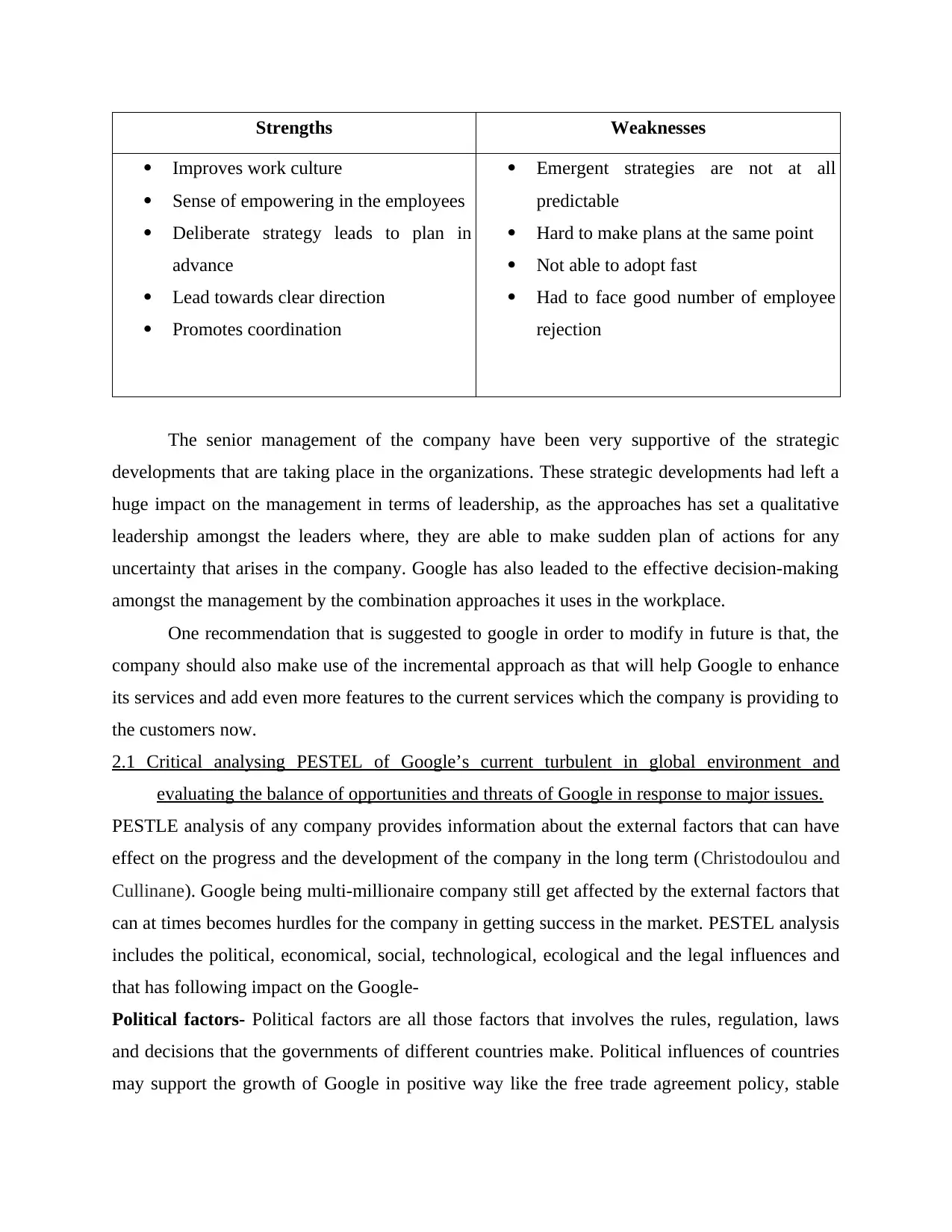
Strengths Weaknesses
Improves work culture
Sense of empowering in the employees
Deliberate strategy leads to plan in
advance
Lead towards clear direction
Promotes coordination
Emergent strategies are not at all
predictable
Hard to make plans at the same point
Not able to adopt fast
Had to face good number of employee
rejection
The senior management of the company have been very supportive of the strategic
developments that are taking place in the organizations. These strategic developments had left a
huge impact on the management in terms of leadership, as the approaches has set a qualitative
leadership amongst the leaders where, they are able to make sudden plan of actions for any
uncertainty that arises in the company. Google has also leaded to the effective decision-making
amongst the management by the combination approaches it uses in the workplace.
One recommendation that is suggested to google in order to modify in future is that, the
company should also make use of the incremental approach as that will help Google to enhance
its services and add even more features to the current services which the company is providing to
the customers now.
2.1 Critical analysing PESTEL of Google’s current turbulent in global environment and
evaluating the balance of opportunities and threats of Google in response to major issues.
PESTLE analysis of any company provides information about the external factors that can have
effect on the progress and the development of the company in the long term (Christodoulou and
Cullinane). Google being multi-millionaire company still get affected by the external factors that
can at times becomes hurdles for the company in getting success in the market. PESTEL analysis
includes the political, economical, social, technological, ecological and the legal influences and
that has following impact on the Google-
Political factors- Political factors are all those factors that involves the rules, regulation, laws
and decisions that the governments of different countries make. Political influences of countries
may support the growth of Google in positive way like the free trade agreement policy, stable
Improves work culture
Sense of empowering in the employees
Deliberate strategy leads to plan in
advance
Lead towards clear direction
Promotes coordination
Emergent strategies are not at all
predictable
Hard to make plans at the same point
Not able to adopt fast
Had to face good number of employee
rejection
The senior management of the company have been very supportive of the strategic
developments that are taking place in the organizations. These strategic developments had left a
huge impact on the management in terms of leadership, as the approaches has set a qualitative
leadership amongst the leaders where, they are able to make sudden plan of actions for any
uncertainty that arises in the company. Google has also leaded to the effective decision-making
amongst the management by the combination approaches it uses in the workplace.
One recommendation that is suggested to google in order to modify in future is that, the
company should also make use of the incremental approach as that will help Google to enhance
its services and add even more features to the current services which the company is providing to
the customers now.
2.1 Critical analysing PESTEL of Google’s current turbulent in global environment and
evaluating the balance of opportunities and threats of Google in response to major issues.
PESTLE analysis of any company provides information about the external factors that can have
effect on the progress and the development of the company in the long term (Christodoulou and
Cullinane). Google being multi-millionaire company still get affected by the external factors that
can at times becomes hurdles for the company in getting success in the market. PESTEL analysis
includes the political, economical, social, technological, ecological and the legal influences and
that has following impact on the Google-
Political factors- Political factors are all those factors that involves the rules, regulation, laws
and decisions that the governments of different countries make. Political influences of countries
may support the growth of Google in positive way like the free trade agreement policy, stable

political scenario and the good market conditions. At times there are some negative influences as
well in the market like the government enterprise that give good competition to the companies
like Google. Political factors are important in running the organization.
Economic factors- Economic factors are those factors that have impact on the company's
financial status. Most of the countries in market today are welcoming technology related
companies that can be favourable to the google. But there are certain countries that are opting for
closed door policy after covid-19 which can become hinder for the growth of the company
(Pokhrel and Chhetri, 2021). The other factors that influence Google is the growth of developing
countries and decreasing cost of the renewable energy. These are the opportunities that Google
can use for entering new markets.
Social factors- Social factors are those external factors that includes the norms, expectations, life
style, health etc. of the people. Privacy policy of many countries is big concern for the Google
company, at the same many individual are claiming that add policy of Google is stopping their
data from being revealed on internet. The raising social media platforms like Instagram and
YouTube are also threatening Google presence in the market as people are becoming interested
in posting their add on social media platforms.
Technological factors- Technological factors are factors that are related with the existence,
development and the availability of the technology (Hewage and et.al., 2018). Technological
factors are in favour of Google because of increasing demand of the internet day by day. Al and
cloud based technologies are also getting popularity. Google's constant efforts in updating their
products and services is plus point as then no technology can harm Google. The google also
ensure that its platforms are safe from the viruses and the hackers so that users find this more
beneficial to use (Haseeb, and et.al.,2019).
Ecological factors- Ecological factors are all those factors that are related with the surrounding
environment and concerned about the ecology. Google can support ecology by taking initiative
of go green in his projects. This is done for those users that are interested and are concerned
about the environment and ecology. Google is focusing on maintaining sustainable relation with
the people Google connects to give good impression to its users. It also takes part and initiative
in fulfilling CSR that is the corporate social responsibility.
Legal factors- Legal factors those factors that are related with the changes in the legislation,
imports/exports, taxation etc. There are factors that have negative impact on the Google like the
well in the market like the government enterprise that give good competition to the companies
like Google. Political factors are important in running the organization.
Economic factors- Economic factors are those factors that have impact on the company's
financial status. Most of the countries in market today are welcoming technology related
companies that can be favourable to the google. But there are certain countries that are opting for
closed door policy after covid-19 which can become hinder for the growth of the company
(Pokhrel and Chhetri, 2021). The other factors that influence Google is the growth of developing
countries and decreasing cost of the renewable energy. These are the opportunities that Google
can use for entering new markets.
Social factors- Social factors are those external factors that includes the norms, expectations, life
style, health etc. of the people. Privacy policy of many countries is big concern for the Google
company, at the same many individual are claiming that add policy of Google is stopping their
data from being revealed on internet. The raising social media platforms like Instagram and
YouTube are also threatening Google presence in the market as people are becoming interested
in posting their add on social media platforms.
Technological factors- Technological factors are factors that are related with the existence,
development and the availability of the technology (Hewage and et.al., 2018). Technological
factors are in favour of Google because of increasing demand of the internet day by day. Al and
cloud based technologies are also getting popularity. Google's constant efforts in updating their
products and services is plus point as then no technology can harm Google. The google also
ensure that its platforms are safe from the viruses and the hackers so that users find this more
beneficial to use (Haseeb, and et.al.,2019).
Ecological factors- Ecological factors are all those factors that are related with the surrounding
environment and concerned about the ecology. Google can support ecology by taking initiative
of go green in his projects. This is done for those users that are interested and are concerned
about the environment and ecology. Google is focusing on maintaining sustainable relation with
the people Google connects to give good impression to its users. It also takes part and initiative
in fulfilling CSR that is the corporate social responsibility.
Legal factors- Legal factors those factors that are related with the changes in the legislation,
imports/exports, taxation etc. There are factors that have negative impact on the Google like the
⊘ This is a preview!⊘
Do you want full access?
Subscribe today to unlock all pages.

Trusted by 1+ million students worldwide
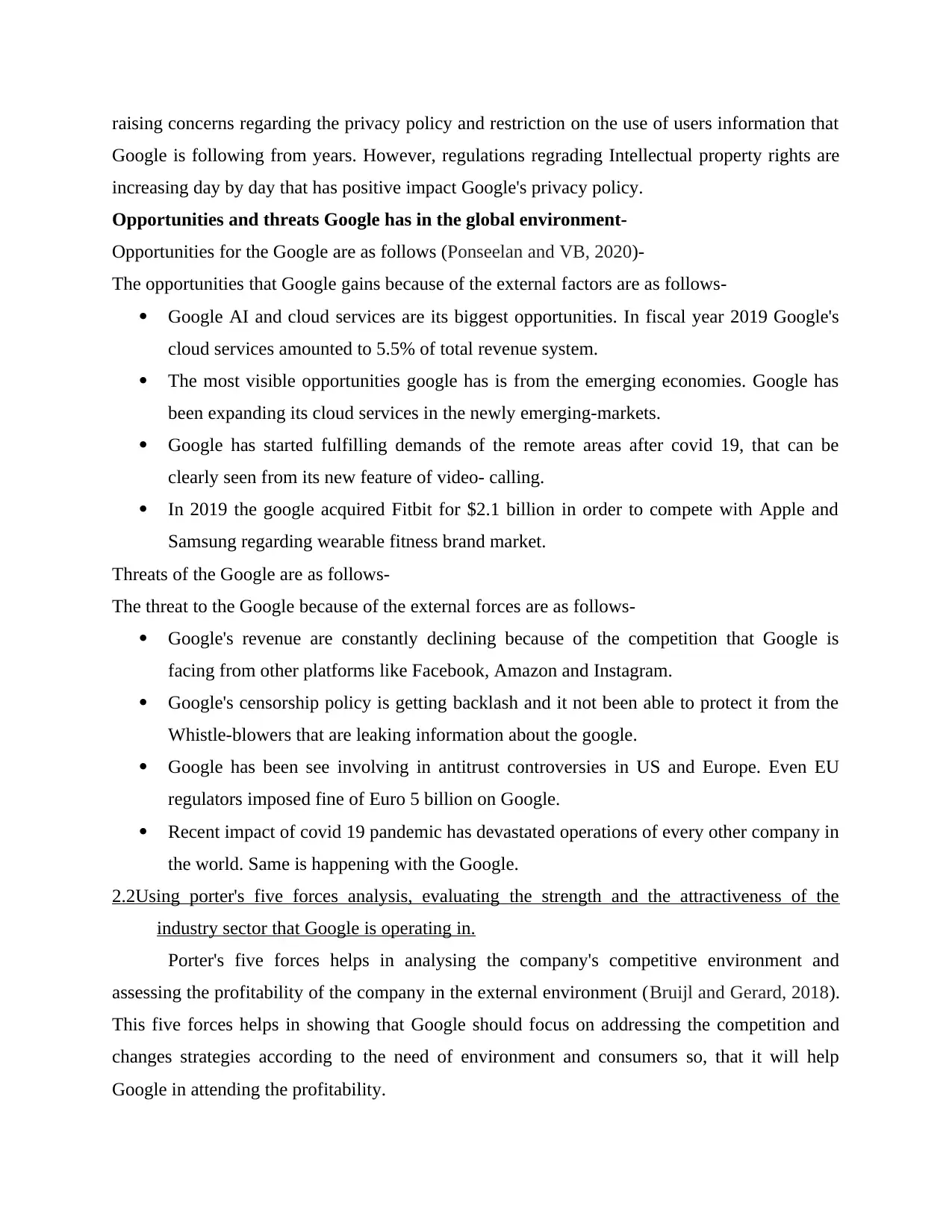
raising concerns regarding the privacy policy and restriction on the use of users information that
Google is following from years. However, regulations regrading Intellectual property rights are
increasing day by day that has positive impact Google's privacy policy.
Opportunities and threats Google has in the global environment-
Opportunities for the Google are as follows (Ponseelan and VB, 2020)-
The opportunities that Google gains because of the external factors are as follows-
Google AI and cloud services are its biggest opportunities. In fiscal year 2019 Google's
cloud services amounted to 5.5% of total revenue system.
The most visible opportunities google has is from the emerging economies. Google has
been expanding its cloud services in the newly emerging-markets.
Google has started fulfilling demands of the remote areas after covid 19, that can be
clearly seen from its new feature of video- calling.
In 2019 the google acquired Fitbit for $2.1 billion in order to compete with Apple and
Samsung regarding wearable fitness brand market.
Threats of the Google are as follows-
The threat to the Google because of the external forces are as follows-
Google's revenue are constantly declining because of the competition that Google is
facing from other platforms like Facebook, Amazon and Instagram.
Google's censorship policy is getting backlash and it not been able to protect it from the
Whistle-blowers that are leaking information about the google.
Google has been see involving in antitrust controversies in US and Europe. Even EU
regulators imposed fine of Euro 5 billion on Google.
Recent impact of covid 19 pandemic has devastated operations of every other company in
the world. Same is happening with the Google.
2.2Using porter's five forces analysis, evaluating the strength and the attractiveness of the
industry sector that Google is operating in.
Porter's five forces helps in analysing the company's competitive environment and
assessing the profitability of the company in the external environment (Bruijl and Gerard, 2018).
This five forces helps in showing that Google should focus on addressing the competition and
changes strategies according to the need of environment and consumers so, that it will help
Google in attending the profitability.
Google is following from years. However, regulations regrading Intellectual property rights are
increasing day by day that has positive impact Google's privacy policy.
Opportunities and threats Google has in the global environment-
Opportunities for the Google are as follows (Ponseelan and VB, 2020)-
The opportunities that Google gains because of the external factors are as follows-
Google AI and cloud services are its biggest opportunities. In fiscal year 2019 Google's
cloud services amounted to 5.5% of total revenue system.
The most visible opportunities google has is from the emerging economies. Google has
been expanding its cloud services in the newly emerging-markets.
Google has started fulfilling demands of the remote areas after covid 19, that can be
clearly seen from its new feature of video- calling.
In 2019 the google acquired Fitbit for $2.1 billion in order to compete with Apple and
Samsung regarding wearable fitness brand market.
Threats of the Google are as follows-
The threat to the Google because of the external forces are as follows-
Google's revenue are constantly declining because of the competition that Google is
facing from other platforms like Facebook, Amazon and Instagram.
Google's censorship policy is getting backlash and it not been able to protect it from the
Whistle-blowers that are leaking information about the google.
Google has been see involving in antitrust controversies in US and Europe. Even EU
regulators imposed fine of Euro 5 billion on Google.
Recent impact of covid 19 pandemic has devastated operations of every other company in
the world. Same is happening with the Google.
2.2Using porter's five forces analysis, evaluating the strength and the attractiveness of the
industry sector that Google is operating in.
Porter's five forces helps in analysing the company's competitive environment and
assessing the profitability of the company in the external environment (Bruijl and Gerard, 2018).
This five forces helps in showing that Google should focus on addressing the competition and
changes strategies according to the need of environment and consumers so, that it will help
Google in attending the profitability.
Paraphrase This Document
Need a fresh take? Get an instant paraphrase of this document with our AI Paraphraser
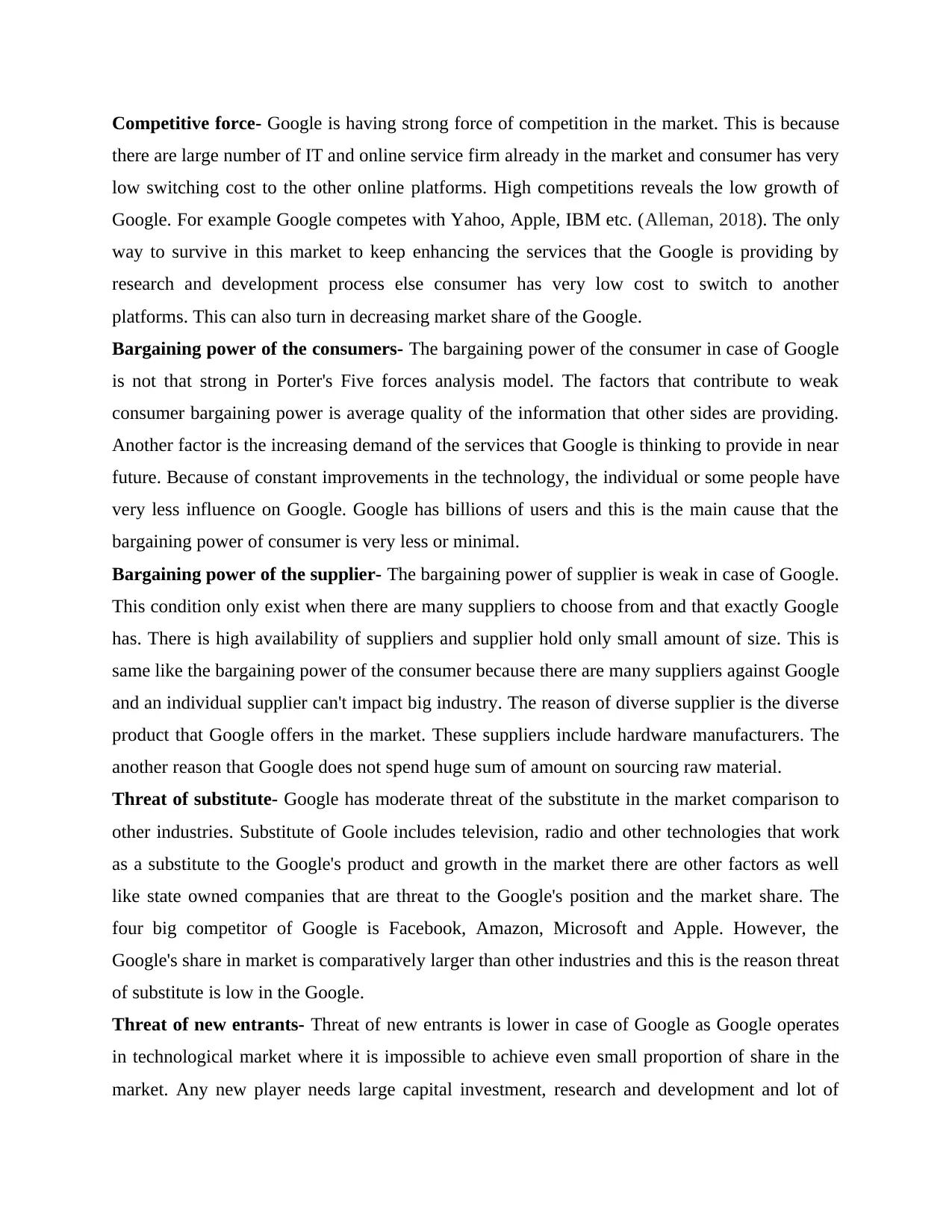
Competitive force- Google is having strong force of competition in the market. This is because
there are large number of IT and online service firm already in the market and consumer has very
low switching cost to the other online platforms. High competitions reveals the low growth of
Google. For example Google competes with Yahoo, Apple, IBM etc. (Alleman, 2018). The only
way to survive in this market to keep enhancing the services that the Google is providing by
research and development process else consumer has very low cost to switch to another
platforms. This can also turn in decreasing market share of the Google.
Bargaining power of the consumers- The bargaining power of the consumer in case of Google
is not that strong in Porter's Five forces analysis model. The factors that contribute to weak
consumer bargaining power is average quality of the information that other sides are providing.
Another factor is the increasing demand of the services that Google is thinking to provide in near
future. Because of constant improvements in the technology, the individual or some people have
very less influence on Google. Google has billions of users and this is the main cause that the
bargaining power of consumer is very less or minimal.
Bargaining power of the supplier- The bargaining power of supplier is weak in case of Google.
This condition only exist when there are many suppliers to choose from and that exactly Google
has. There is high availability of suppliers and supplier hold only small amount of size. This is
same like the bargaining power of the consumer because there are many suppliers against Google
and an individual supplier can't impact big industry. The reason of diverse supplier is the diverse
product that Google offers in the market. These suppliers include hardware manufacturers. The
another reason that Google does not spend huge sum of amount on sourcing raw material.
Threat of substitute- Google has moderate threat of the substitute in the market comparison to
other industries. Substitute of Goole includes television, radio and other technologies that work
as a substitute to the Google's product and growth in the market there are other factors as well
like state owned companies that are threat to the Google's position and the market share. The
four big competitor of Google is Facebook, Amazon, Microsoft and Apple. However, the
Google's share in market is comparatively larger than other industries and this is the reason threat
of substitute is low in the Google.
Threat of new entrants- Threat of new entrants is lower in case of Google as Google operates
in technological market where it is impossible to achieve even small proportion of share in the
market. Any new player needs large capital investment, research and development and lot of
there are large number of IT and online service firm already in the market and consumer has very
low switching cost to the other online platforms. High competitions reveals the low growth of
Google. For example Google competes with Yahoo, Apple, IBM etc. (Alleman, 2018). The only
way to survive in this market to keep enhancing the services that the Google is providing by
research and development process else consumer has very low cost to switch to another
platforms. This can also turn in decreasing market share of the Google.
Bargaining power of the consumers- The bargaining power of the consumer in case of Google
is not that strong in Porter's Five forces analysis model. The factors that contribute to weak
consumer bargaining power is average quality of the information that other sides are providing.
Another factor is the increasing demand of the services that Google is thinking to provide in near
future. Because of constant improvements in the technology, the individual or some people have
very less influence on Google. Google has billions of users and this is the main cause that the
bargaining power of consumer is very less or minimal.
Bargaining power of the supplier- The bargaining power of supplier is weak in case of Google.
This condition only exist when there are many suppliers to choose from and that exactly Google
has. There is high availability of suppliers and supplier hold only small amount of size. This is
same like the bargaining power of the consumer because there are many suppliers against Google
and an individual supplier can't impact big industry. The reason of diverse supplier is the diverse
product that Google offers in the market. These suppliers include hardware manufacturers. The
another reason that Google does not spend huge sum of amount on sourcing raw material.
Threat of substitute- Google has moderate threat of the substitute in the market comparison to
other industries. Substitute of Goole includes television, radio and other technologies that work
as a substitute to the Google's product and growth in the market there are other factors as well
like state owned companies that are threat to the Google's position and the market share. The
four big competitor of Google is Facebook, Amazon, Microsoft and Apple. However, the
Google's share in market is comparatively larger than other industries and this is the reason threat
of substitute is low in the Google.
Threat of new entrants- Threat of new entrants is lower in case of Google as Google operates
in technological market where it is impossible to achieve even small proportion of share in the
market. Any new player needs large capital investment, research and development and lot of
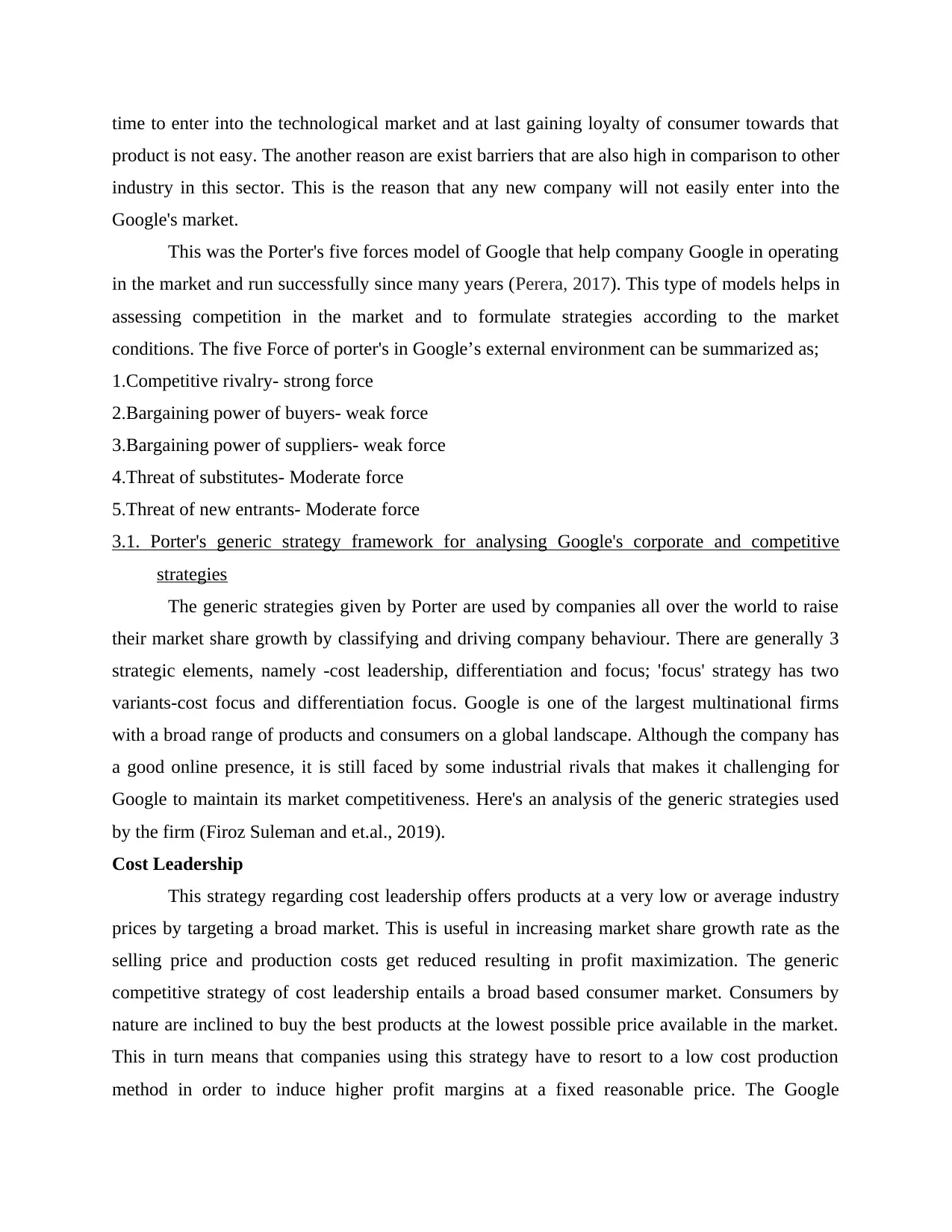
time to enter into the technological market and at last gaining loyalty of consumer towards that
product is not easy. The another reason are exist barriers that are also high in comparison to other
industry in this sector. This is the reason that any new company will not easily enter into the
Google's market.
This was the Porter's five forces model of Google that help company Google in operating
in the market and run successfully since many years (Perera, 2017). This type of models helps in
assessing competition in the market and to formulate strategies according to the market
conditions. The five Force of porter's in Google’s external environment can be summarized as;
1.Competitive rivalry- strong force
2.Bargaining power of buyers- weak force
3.Bargaining power of suppliers- weak force
4.Threat of substitutes- Moderate force
5.Threat of new entrants- Moderate force
3.1. Porter's generic strategy framework for analysing Google's corporate and competitive
strategies
The generic strategies given by Porter are used by companies all over the world to raise
their market share growth by classifying and driving company behaviour. There are generally 3
strategic elements, namely -cost leadership, differentiation and focus; 'focus' strategy has two
variants-cost focus and differentiation focus. Google is one of the largest multinational firms
with a broad range of products and consumers on a global landscape. Although the company has
a good online presence, it is still faced by some industrial rivals that makes it challenging for
Google to maintain its market competitiveness. Here's an analysis of the generic strategies used
by the firm (Firoz Suleman and et.al., 2019).
Cost Leadership
This strategy regarding cost leadership offers products at a very low or average industry
prices by targeting a broad market. This is useful in increasing market share growth rate as the
selling price and production costs get reduced resulting in profit maximization. The generic
competitive strategy of cost leadership entails a broad based consumer market. Consumers by
nature are inclined to buy the best products at the lowest possible price available in the market.
This in turn means that companies using this strategy have to resort to a low cost production
method in order to induce higher profit margins at a fixed reasonable price. The Google
product is not easy. The another reason are exist barriers that are also high in comparison to other
industry in this sector. This is the reason that any new company will not easily enter into the
Google's market.
This was the Porter's five forces model of Google that help company Google in operating
in the market and run successfully since many years (Perera, 2017). This type of models helps in
assessing competition in the market and to formulate strategies according to the market
conditions. The five Force of porter's in Google’s external environment can be summarized as;
1.Competitive rivalry- strong force
2.Bargaining power of buyers- weak force
3.Bargaining power of suppliers- weak force
4.Threat of substitutes- Moderate force
5.Threat of new entrants- Moderate force
3.1. Porter's generic strategy framework for analysing Google's corporate and competitive
strategies
The generic strategies given by Porter are used by companies all over the world to raise
their market share growth by classifying and driving company behaviour. There are generally 3
strategic elements, namely -cost leadership, differentiation and focus; 'focus' strategy has two
variants-cost focus and differentiation focus. Google is one of the largest multinational firms
with a broad range of products and consumers on a global landscape. Although the company has
a good online presence, it is still faced by some industrial rivals that makes it challenging for
Google to maintain its market competitiveness. Here's an analysis of the generic strategies used
by the firm (Firoz Suleman and et.al., 2019).
Cost Leadership
This strategy regarding cost leadership offers products at a very low or average industry
prices by targeting a broad market. This is useful in increasing market share growth rate as the
selling price and production costs get reduced resulting in profit maximization. The generic
competitive strategy of cost leadership entails a broad based consumer market. Consumers by
nature are inclined to buy the best products at the lowest possible price available in the market.
This in turn means that companies using this strategy have to resort to a low cost production
method in order to induce higher profit margins at a fixed reasonable price. The Google
⊘ This is a preview!⊘
Do you want full access?
Subscribe today to unlock all pages.

Trusted by 1+ million students worldwide

corporation uses cost leadership as its primary business tool with emphasis on selling low priced
products to its consumers.
Differentiation
The differentiation strategy includes a qualitative production capacity by offering goods
and services that place a unique proposition in front of the customers as compared to the
competitors. This strategic differentiation can be achieved through a innovative research and
development sector. Differentiating usually means tweaking products and its features as per the
popular market demand which appeals to customer needs. In this regard the multinational firm
Google LLC (formerly Google Inc.) works exceptionally well in using this strategy within its
business framework as it emphasizes putting its consumers' requirements first (Yin and et.al.,
2020).
This strategy includes tailoring the goods and services according to the market segment
needs. It also involves good amount of research driven product development. For instance,
Google majorly uses the approach of differentiation for obtaining a good competitive advantage
over its competitors such as Snap Inc., Amazon, etc. by launching unique products like cloud
software, tablets, laptops, and more that suits its customers' tastes.
Cost Focus
The focus strategy has two variants namely cost and differentiation focus. The first
variation of cost focus targets a niche market and offers product or services at a lower price. The
Focus strategy has to be very transparent pertaining to its market cost sensitivity. The core aspect
of it is to add something new and productive to the existing market. More importantly this type
of strategic method generally operates in a narrow market zone where the focus is on a few
selected segments instead of a broad ranged spectrum. If Google LLC uses this approach within
its online advertising division then it might help in attracting a niche customer segment.
Differentiation Focus
The differentiation focus is a generic focus strategy that puts emphasis on a niche market
but offers a product or service that is unique in the market. In this competitive generic strategy,
increasing importance is given to product features rather than its cost. This focus strategy is
applicable in the narrow scope of market production. Emphasis on a particular need or consumer
requirement can be fulfilled through this business strategy. For instance, different segment needs
such as application programming has been effectively channelled by Google with a differentiated
products to its consumers.
Differentiation
The differentiation strategy includes a qualitative production capacity by offering goods
and services that place a unique proposition in front of the customers as compared to the
competitors. This strategic differentiation can be achieved through a innovative research and
development sector. Differentiating usually means tweaking products and its features as per the
popular market demand which appeals to customer needs. In this regard the multinational firm
Google LLC (formerly Google Inc.) works exceptionally well in using this strategy within its
business framework as it emphasizes putting its consumers' requirements first (Yin and et.al.,
2020).
This strategy includes tailoring the goods and services according to the market segment
needs. It also involves good amount of research driven product development. For instance,
Google majorly uses the approach of differentiation for obtaining a good competitive advantage
over its competitors such as Snap Inc., Amazon, etc. by launching unique products like cloud
software, tablets, laptops, and more that suits its customers' tastes.
Cost Focus
The focus strategy has two variants namely cost and differentiation focus. The first
variation of cost focus targets a niche market and offers product or services at a lower price. The
Focus strategy has to be very transparent pertaining to its market cost sensitivity. The core aspect
of it is to add something new and productive to the existing market. More importantly this type
of strategic method generally operates in a narrow market zone where the focus is on a few
selected segments instead of a broad ranged spectrum. If Google LLC uses this approach within
its online advertising division then it might help in attracting a niche customer segment.
Differentiation Focus
The differentiation focus is a generic focus strategy that puts emphasis on a niche market
but offers a product or service that is unique in the market. In this competitive generic strategy,
increasing importance is given to product features rather than its cost. This focus strategy is
applicable in the narrow scope of market production. Emphasis on a particular need or consumer
requirement can be fulfilled through this business strategy. For instance, different segment needs
such as application programming has been effectively channelled by Google with a differentiated
Paraphrase This Document
Need a fresh take? Get an instant paraphrase of this document with our AI Paraphraser
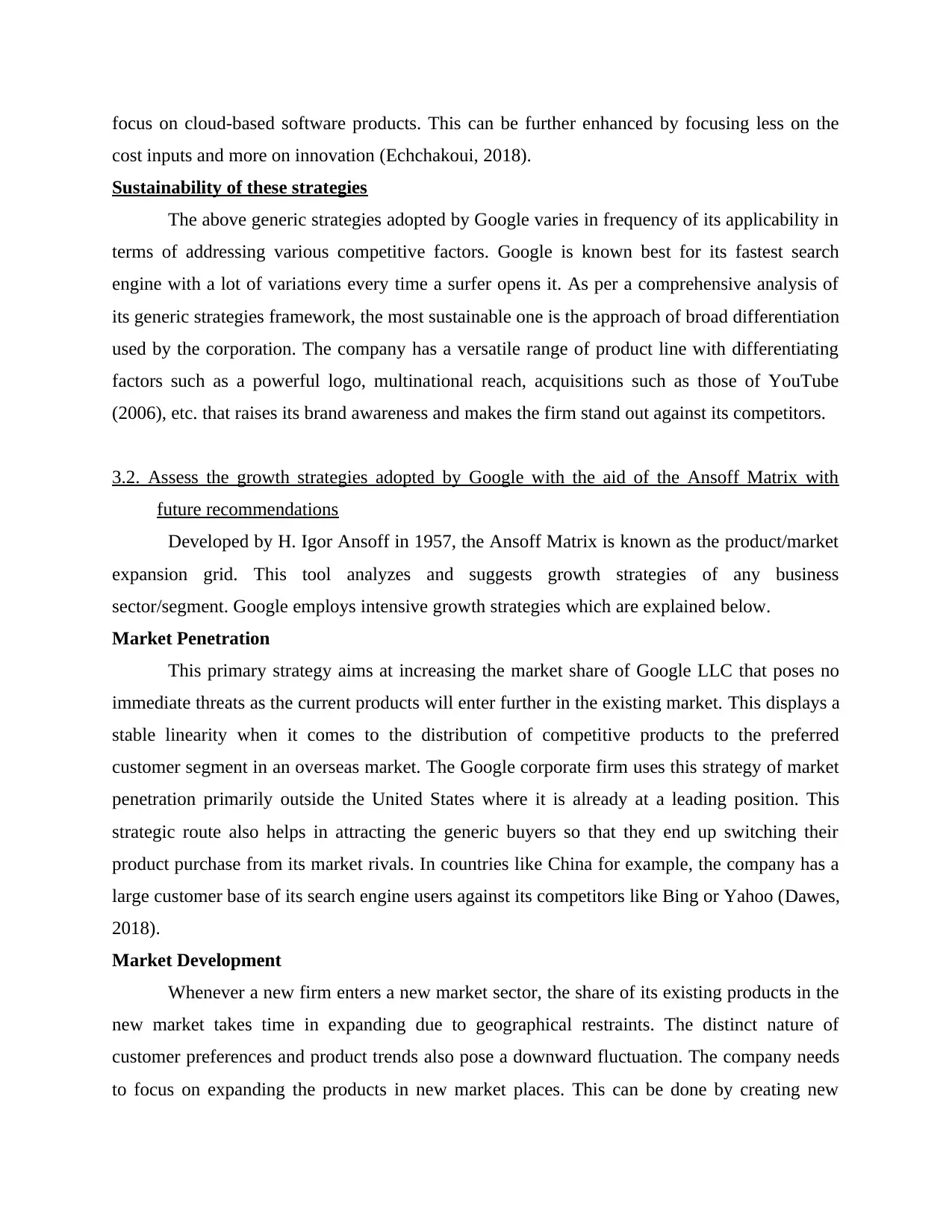
focus on cloud-based software products. This can be further enhanced by focusing less on the
cost inputs and more on innovation (Echchakoui, 2018).
Sustainability of these strategies
The above generic strategies adopted by Google varies in frequency of its applicability in
terms of addressing various competitive factors. Google is known best for its fastest search
engine with a lot of variations every time a surfer opens it. As per a comprehensive analysis of
its generic strategies framework, the most sustainable one is the approach of broad differentiation
used by the corporation. The company has a versatile range of product line with differentiating
factors such as a powerful logo, multinational reach, acquisitions such as those of YouTube
(2006), etc. that raises its brand awareness and makes the firm stand out against its competitors.
3.2. Assess the growth strategies adopted by Google with the aid of the Ansoff Matrix with
future recommendations
Developed by H. Igor Ansoff in 1957, the Ansoff Matrix is known as the product/market
expansion grid. This tool analyzes and suggests growth strategies of any business
sector/segment. Google employs intensive growth strategies which are explained below.
Market Penetration
This primary strategy aims at increasing the market share of Google LLC that poses no
immediate threats as the current products will enter further in the existing market. This displays a
stable linearity when it comes to the distribution of competitive products to the preferred
customer segment in an overseas market. The Google corporate firm uses this strategy of market
penetration primarily outside the United States where it is already at a leading position. This
strategic route also helps in attracting the generic buyers so that they end up switching their
product purchase from its market rivals. In countries like China for example, the company has a
large customer base of its search engine users against its competitors like Bing or Yahoo (Dawes,
2018).
Market Development
Whenever a new firm enters a new market sector, the share of its existing products in the
new market takes time in expanding due to geographical restraints. The distinct nature of
customer preferences and product trends also pose a downward fluctuation. The company needs
to focus on expanding the products in new market places. This can be done by creating new
cost inputs and more on innovation (Echchakoui, 2018).
Sustainability of these strategies
The above generic strategies adopted by Google varies in frequency of its applicability in
terms of addressing various competitive factors. Google is known best for its fastest search
engine with a lot of variations every time a surfer opens it. As per a comprehensive analysis of
its generic strategies framework, the most sustainable one is the approach of broad differentiation
used by the corporation. The company has a versatile range of product line with differentiating
factors such as a powerful logo, multinational reach, acquisitions such as those of YouTube
(2006), etc. that raises its brand awareness and makes the firm stand out against its competitors.
3.2. Assess the growth strategies adopted by Google with the aid of the Ansoff Matrix with
future recommendations
Developed by H. Igor Ansoff in 1957, the Ansoff Matrix is known as the product/market
expansion grid. This tool analyzes and suggests growth strategies of any business
sector/segment. Google employs intensive growth strategies which are explained below.
Market Penetration
This primary strategy aims at increasing the market share of Google LLC that poses no
immediate threats as the current products will enter further in the existing market. This displays a
stable linearity when it comes to the distribution of competitive products to the preferred
customer segment in an overseas market. The Google corporate firm uses this strategy of market
penetration primarily outside the United States where it is already at a leading position. This
strategic route also helps in attracting the generic buyers so that they end up switching their
product purchase from its market rivals. In countries like China for example, the company has a
large customer base of its search engine users against its competitors like Bing or Yahoo (Dawes,
2018).
Market Development
Whenever a new firm enters a new market sector, the share of its existing products in the
new market takes time in expanding due to geographical restraints. The distinct nature of
customer preferences and product trends also pose a downward fluctuation. The company needs
to focus on expanding the products in new market places. This can be done by creating new
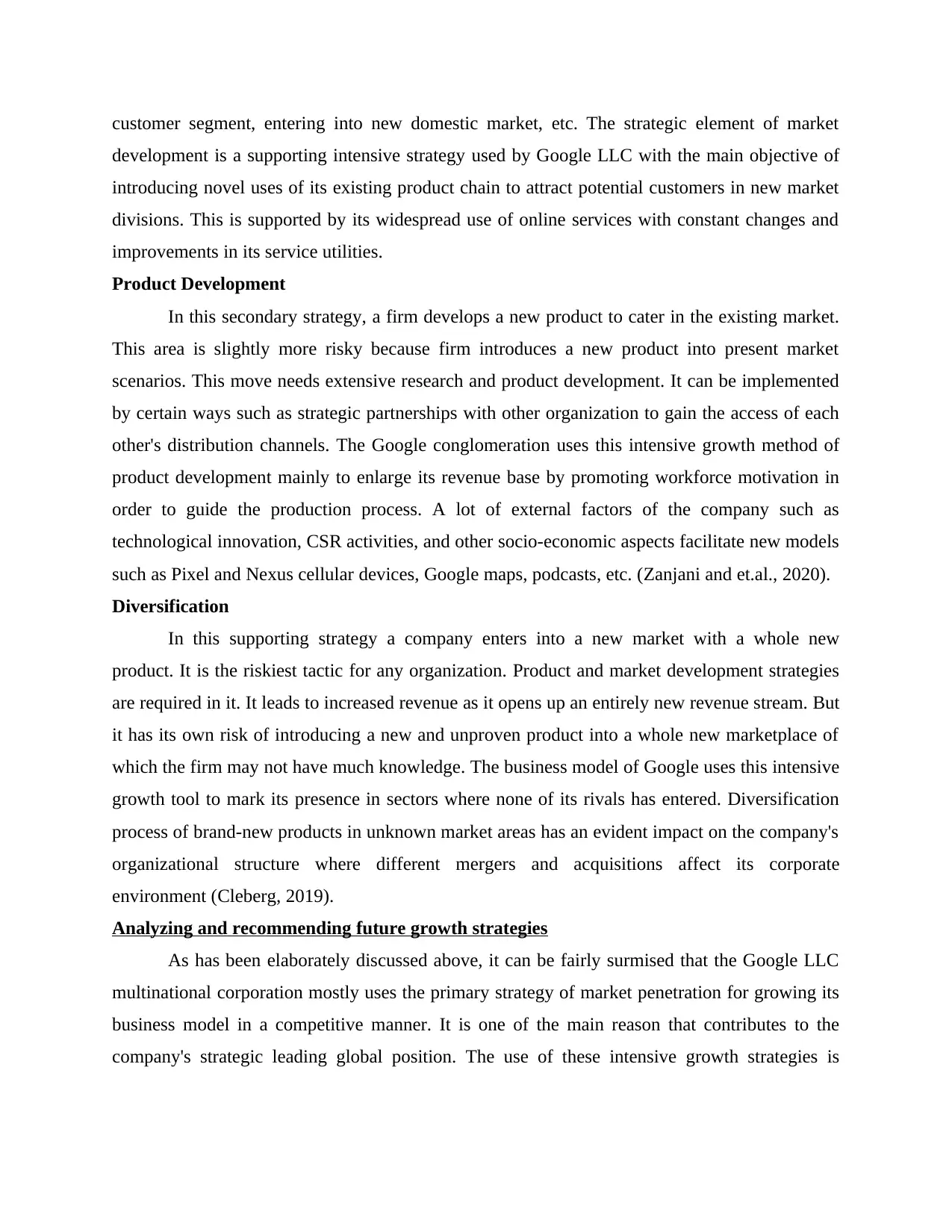
customer segment, entering into new domestic market, etc. The strategic element of market
development is a supporting intensive strategy used by Google LLC with the main objective of
introducing novel uses of its existing product chain to attract potential customers in new market
divisions. This is supported by its widespread use of online services with constant changes and
improvements in its service utilities.
Product Development
In this secondary strategy, a firm develops a new product to cater in the existing market.
This area is slightly more risky because firm introduces a new product into present market
scenarios. This move needs extensive research and product development. It can be implemented
by certain ways such as strategic partnerships with other organization to gain the access of each
other's distribution channels. The Google conglomeration uses this intensive growth method of
product development mainly to enlarge its revenue base by promoting workforce motivation in
order to guide the production process. A lot of external factors of the company such as
technological innovation, CSR activities, and other socio-economic aspects facilitate new models
such as Pixel and Nexus cellular devices, Google maps, podcasts, etc. (Zanjani and et.al., 2020).
Diversification
In this supporting strategy a company enters into a new market with a whole new
product. It is the riskiest tactic for any organization. Product and market development strategies
are required in it. It leads to increased revenue as it opens up an entirely new revenue stream. But
it has its own risk of introducing a new and unproven product into a whole new marketplace of
which the firm may not have much knowledge. The business model of Google uses this intensive
growth tool to mark its presence in sectors where none of its rivals has entered. Diversification
process of brand-new products in unknown market areas has an evident impact on the company's
organizational structure where different mergers and acquisitions affect its corporate
environment (Cleberg, 2019).
Analyzing and recommending future growth strategies
As has been elaborately discussed above, it can be fairly surmised that the Google LLC
multinational corporation mostly uses the primary strategy of market penetration for growing its
business model in a competitive manner. It is one of the main reason that contributes to the
company's strategic leading global position. The use of these intensive growth strategies is
development is a supporting intensive strategy used by Google LLC with the main objective of
introducing novel uses of its existing product chain to attract potential customers in new market
divisions. This is supported by its widespread use of online services with constant changes and
improvements in its service utilities.
Product Development
In this secondary strategy, a firm develops a new product to cater in the existing market.
This area is slightly more risky because firm introduces a new product into present market
scenarios. This move needs extensive research and product development. It can be implemented
by certain ways such as strategic partnerships with other organization to gain the access of each
other's distribution channels. The Google conglomeration uses this intensive growth method of
product development mainly to enlarge its revenue base by promoting workforce motivation in
order to guide the production process. A lot of external factors of the company such as
technological innovation, CSR activities, and other socio-economic aspects facilitate new models
such as Pixel and Nexus cellular devices, Google maps, podcasts, etc. (Zanjani and et.al., 2020).
Diversification
In this supporting strategy a company enters into a new market with a whole new
product. It is the riskiest tactic for any organization. Product and market development strategies
are required in it. It leads to increased revenue as it opens up an entirely new revenue stream. But
it has its own risk of introducing a new and unproven product into a whole new marketplace of
which the firm may not have much knowledge. The business model of Google uses this intensive
growth tool to mark its presence in sectors where none of its rivals has entered. Diversification
process of brand-new products in unknown market areas has an evident impact on the company's
organizational structure where different mergers and acquisitions affect its corporate
environment (Cleberg, 2019).
Analyzing and recommending future growth strategies
As has been elaborately discussed above, it can be fairly surmised that the Google LLC
multinational corporation mostly uses the primary strategy of market penetration for growing its
business model in a competitive manner. It is one of the main reason that contributes to the
company's strategic leading global position. The use of these intensive growth strategies is
⊘ This is a preview!⊘
Do you want full access?
Subscribe today to unlock all pages.

Trusted by 1+ million students worldwide
1 out of 15
Related Documents
Your All-in-One AI-Powered Toolkit for Academic Success.
+13062052269
info@desklib.com
Available 24*7 on WhatsApp / Email
![[object Object]](/_next/static/media/star-bottom.7253800d.svg)
Unlock your academic potential
Copyright © 2020–2025 A2Z Services. All Rights Reserved. Developed and managed by ZUCOL.


